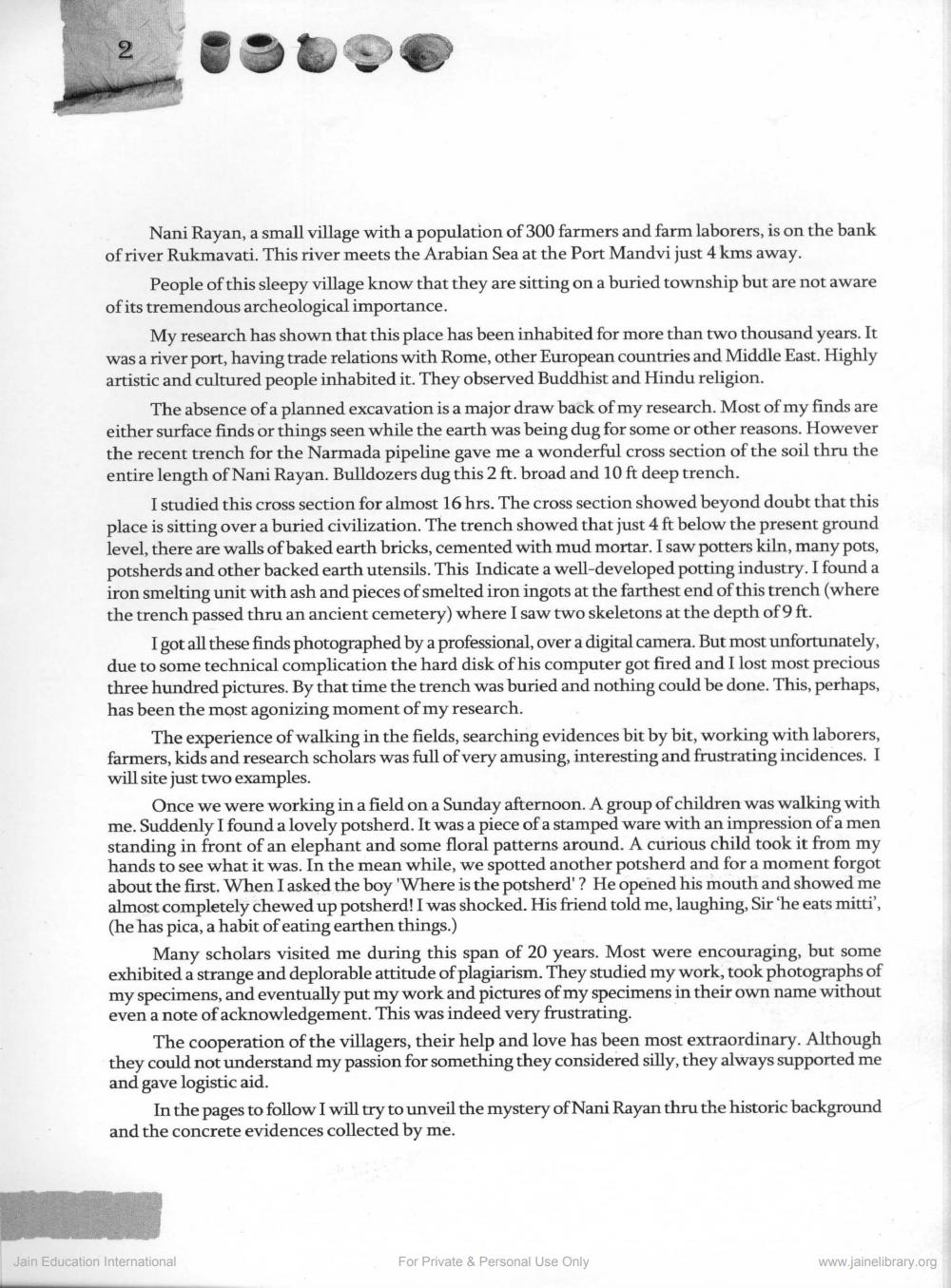Book Title: Nani Rayan Author(s): Pulin Vasa Publisher: Kalikal Sarvagya Shri Hemchandracharya Navam Janmashatabdi Smruti Sanskar Shikshannidhi Ahmedabad View full book textPage 9
________________ 2 Nani Rayan, a small village with a population of 300 farmers and farm laborers, is on the bank of river Rukmavati. This river meets the Arabian Sea at the Port Mandvi just 4 kms away. People of this sleepy village know that they are sitting on a buried township but are not aware of its tremendous archeological importance. My research has shown that this place has been inhabited for more than two thousand years. It was a river port, having trade relations with Rome, other European countries and Middle East. Highly artistic and cultured people inhabited it. They observed Buddhist and Hindu religion. The absence of a planned excavation is a major draw back of my research. Most of my finds are either surface finds or things seen while the earth was being dug for some or other reasons. However the recent trench for the Narmada pipeline gave me a wonderful cross section of the soil thru the entire length of Nani Rayan. Bulldozers dug this 2 ft. broad and 10 ft deep trench. I studied this cross section for almost 16 hrs. The cross section showed beyond doubt that this place is sitting over a buried civilization. The trench showed that just 4 ft below the present ground level, there are walls of baked earth bricks, cemented with mud mortar. I saw potters kiln, many pots, potsherds and other backed earth utensils. This Indicate a well-developed potting industry. I found at iron smelting unit with ash and pieces of smelted iron ingots at the farthest end of this trench (where the trench passed thru an ancient cemetery) where I saw two skeletons at the depth of 9 ft. I got all these finds photographed by a professional, over a digital camera. But most unfortunately, due to some technical complication the hard disk of his computer got fired and I lost most precious three hundred pictures. By that time the trench was buried and nothing could be done. This, perhaps, has been the most agonizing moment of my research. The experience of walking in the fields, searching evidences bit by bit, working with laborers, farmers, kids and research scholars was full of very amusing, interesting and frustrating incidences. It will site just two examples. Once we were working in a field on a Sunday afternoon. A group of children was walking with me. Suddenly I found a lovely potsherd. It was a piece of a stamped ware with an impression of a men standing in front of an elephant and some floral patterns around. A curious child took it from my hands to see what it was. In the mean while, we spotted another potsherd and for a moment forgot about the first. When I asked the boy 'Where is the potsherd'? He opened his mouth and showed me almost completely chewed up potsherd! I was shocked. His friend told me, laughing, Sir he eats mitti", (he has pica, a habit of eating earthen things.) Many scholars visited me during this span of 20 years. Most were encouraging, but some exhibited a strange and deplorable attitude of plagiarism. They studied my work, took photographs of my specimens, and eventually put my work and pictures of my specimens in their own name without even a note of acknowledgement. This was indeed very frustrating. The cooperation of the villagers, their help and love has been most extraordinary. Although they could not understand my passion for something they considered silly, they always supported me and gave logistic aid. In the pages to follow I will try to unveil the mystery of Nani Rayan thru the historic background and the concrete evidences collected by me. Jain Education International For Private & Personal Use Only www.jainelibrary.orgPage Navigation
1 ... 7 8 9 10 11 12 13 14 15 16 17 18 19 20 21 22 23 24 25 26 27 28 29 30 31 32 33 34 35 36 37 38 39 40 41 42 43 44 45 46 47 48 49 50 51 52 53 54 55 56 57 58 59 60 61 62 63 64 65 66
